Sculpture- A Reflection of Faith
Created for Best of Artists and Artisans Website
By Bridgette Mongeon © 2009
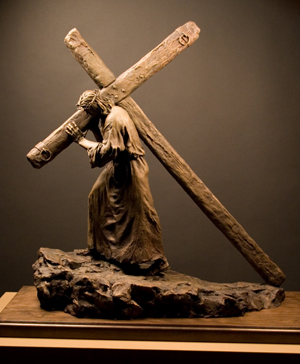
We are in the middle of what some would call a holy season of Lent, leading up to Passover, and then Easter Sunday. This solemn time of reflection in faith caused me to seek sculpture that does the same. In this month’s article we will showcase the work of traditional “liturgical art,” as well as not so traditional art based on the faith or with a message of faith. When reviewing different artists it is important for me to hear the description of the art. A titled work and descriptions add life to the piece, gives it meaning and creates a rapport between viewer, art, and artist. Equally, there is an urgency in my discovery of the process of each individual artist. I want to know more about their own faith. What drives them to spend so many hours creating these images? Is it of necessity that they driven to create? Do they feel a message must be conveyed? Is there a spiritual dance between them and the Great Creator as they mingle passion, art and faith? Here are the answers of five passionate and spiritual artists.
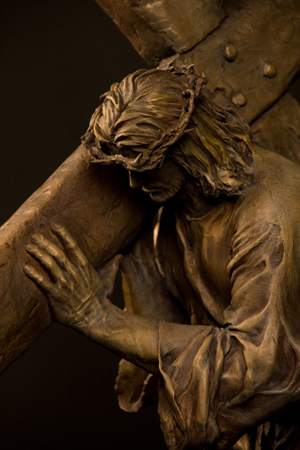
ArtistAngela Johnson
www.ajsculptures.com
Art quietly speaks volumes. At this Easter time it gives me joy to share my pieces, Because of Love and Lazarus, Come Forth. The most fascinating aspect of art for me is what can be communicated from the artist to the viewer. Every artistic decision of compositional design is determined with the desire to share a perspective,
belief or quality about the subject being created. In the sculpture, Because of Love, it was my desire to portray the incomprehensible act of love of Jesus Christ is suffering the weight of the sins of the world. The majesty and power of His love is portrayed and embedded in this work. The strain of His muscles, His bearing being strong, yet submissive to the will of His Father are meant to draw the viewer into contemplation of His Great, Infinite sacrifice of Love.
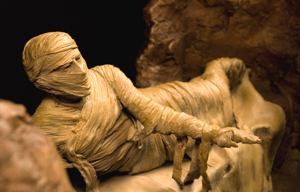
Lazarus, Come Forth sculpturally depicts the miracle of Jesus raising Lazarus from the dead. The biblical account states that Lazarus had been in the grave four days. Beyond all the miracles Jesus Christ had already performed was this yet greater impossibility of raising someone from the dead long after their spirit had left the realm of earth. I think a great deal about the reaction of Mary and Martha as they struggle in amazement and disbelief as they see their brother who was one dead, alive again. When we pray and ask God to grant a blessing or we personally witness a miracle what is our reaction? How grateful and changed are we as we experience the power of God? Do we give God the glory or dismiss it as an unexplainable coincidence?
Artist
William Leslie
www.PaperSunLightsculpture.com
At the heart of existence there shines a light; Ner Tamid, the flame of the Divine’s ever radiant Presence. This light, which emanates from the inside out, expresses the timeless ideals towards which all individuals and nations strive; Wisdom, Love, and Justice.
Wisdom is the knowledge of the true nature of the human condition and the Sacred Mystery; Love is found in the deep concern for the well being of all living things, especially the least advantaged and most vulnerable; and Justice is the manifestation of Wisdom and Love in action, the right ordering of society such that the dignity of all is cherished and protected.
These three virtues are expressed in the three upward aspiring fingers of the flame in this representation of Ner Tamid. Their unity and interdependence is signified by the manner in which the three fingers twist around each other after emerging from a common base.
It is the wish of the artist that this expression of the Eternal Flame inspire every individual and all nations to be exemplary lights to guide humanity through the dark night of these bewildering times, and to remind us of the undying presence of the Divine.

The aesthetic appeal of my lightsculptures is evocative of what we find beautiful in natural forms; the swirl of texture in marble or wood grain, the evolving folds in flowers or lichen, the patterns left in windswept or sea swept sand. Everywhere we look we see that nature prefers to move in graceful trails, or to organize itself in beautiful patterns.
I began thirty years ago calling my work “lanterns” or “artistic light fixtures.” Gradually my work has evolved to become more sculptural, less functional. While my clients (ranging from homes to businesses, hospitals to restaurants) are often seeking a source of illumination for an occupied space, they also desire something that stands alone as a work of art whether the light is on or off. It is this wish to grow beyond the functional, to create truly beautiful illuminated sculptural forms that motivates my efforts now.
Ner Tamid resides in Unitarian Universalist Fellowship in Vista, CA.
ArtistNancy Winship Milliken
www.nancymilliken.com
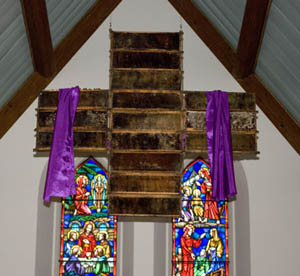
Out of Many, One, dimensions variable upon installation (cross is 51”x51”x2”), wood, beeswax, honey, muslin, steel, 2008.
The piece is constructed out of honey frames from a bee hive. It has the balance of the Red Cross symbol as it hangs suspended from the ceiling. There is a waxed muslin catch-pan filled with honey underneath and waxed muslin is draped over the extended arms of the cross. There is a lovely sweet smell of wax and honey and a depth of natural color of the old honeycomb.
Out of Many, One, II, dimensions variable upon installation (cross is 51”x51”x2”), wood, beeswax, steel, polyester, 2009. The piece is similar to the above Out of Many, One description except without the catch-pan of honey and the material draped is interchangeable, purple for lent, red and black as needed. This cross now installed at Calvary Church in Stonington, Connecticut, will come down for Easter and be replaced with a cross that I have made out of the same frame construction, filled with white flowers.
The Lamb, installation size variable,( 7’, 10’, or 15’) wool, felt, polyester, 2009. The wool has been kept in the raw, so the smell of lanolin and animal is vaguely familiar, ancient, visceral. The wool is needle felted into a felt substrate, using an old technique employed by homesteaders all over the world. The subtle colors and design of the wool, the texture and smell present in contrast to the purple polyester shine adds intrigue and contemplation.
Artist Statement
Art for me is where science and the spiritual connect. For these above mentioned pieces the concepts of sacrifice and service were always front and center. Out of Many, One, is titled for both the collaborative work ethic and social constructs of the honeybee colony and our national motto, E Pluribus Unum, found on the seal of the United States and on our dollar bill. The bees work for the benefit the whole colony, even giving their lives in defense of their productive hive. With the recent colony collapse disorder that the nation’s bees have been experiencing, I believe the materials that I have chosen to be symbolic of not only humanitarian behaviors, but also reflective of our environmental impact on the honeybee.
In choosing the symbol of the cross, and in particular the Red Cross, I am referencing the humanitarian gesture of service to others with disregard to country borders, skin color, sexual orientation, wealth or religion. Anyone who has experienced a natural disaster, a manmade calamity, or even succumbed to the power of water while swimming knows the calming effect of the Red Cross symbol flying on a flag meaning help is near. It is powerful and instills the feeling of hope as well as symbolizing sacrifice and service. The lamb has historically been a symbol of sacrifice. The method of attaching the fiber by pushing the wool into the felt with a long needle is laborious and a nod to the essential work of the homesteader. The contrasting shiny purple material representative of the color for Lent and the practice of doing without highlights the natural and authentic smell and texture of the wool.
As a last note about these pieces: They personally symbolize the faith I have in my art. I made a change in my career two years ago and I need to have faith in the unknown, the unseen, the future. By using untraditional materials unconventionally in my art, I am entering un-chartered territory. These traditional symbols are a reminder, a flag, of faith in my art.
Artist
Robert Winkler
www.robertwinklerscupture.com
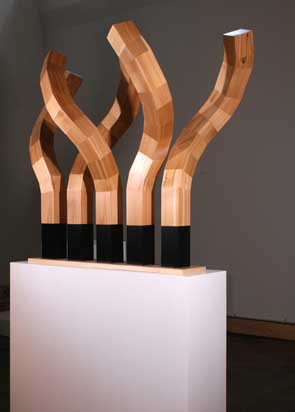
People often ask Robert Winkler what inspired one or another of his sculptures.
But, the more relevant question for Winkler is “what do his abstract forms inspire in the viewer?”—particularly in the case of Look Homeward, Angles. Like all of his works, it is deeply spiritual, humble in its simplicity and lack of ornamentation —with a minimal flow that allows the imagination to soar unimpeded.
In Look Homeward, Angles, his graceful-gravity challenging forms seem to resist the downward pull of the Earth and reach heavenward.
In a recent series of interior sculptures, Grow Up, the prayerful attitudes and upward reach of the twisted forms are both a paean to ephemeral beauty and a moving metaphor for the human struggle to transcend.
Since the early ‘90’s, Robert Winkler has been manipulating volume, mass and balance to create a sense of movement. His interior works make use of surprising combinations of materials, such as aluminum, steel, hand-laid papers, vellum, tempered masonite, and cedar. His large-scale outdoor works are primarily constructed of cedar, an organic material whose surface changes over time. Above all, it is his ability to find infinite variation within a limited number of shapes that sets him apart. Without so much as a single curved cut of wood, he achieves serpentine, animated forms through the use of incremental gradations. It is a discipline that offers no hiding place for error, demanding meticulous workmanship.
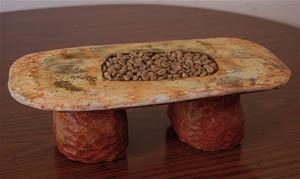
Artist
Sean Matthews
www.flickr.com/photos/seansaltars
My first experience with sculpture dates back to childhood. As a boy, Sunday Mass was the least exciting hour of the week and I often found myself daydreaming. I can think back to a reoccurring daydream of the Church spontaneously bursting into flames during a Sunday morning celebration. While the congregation was frantically storming the doors for safety, I was calmly carrying large marble sculptures of the Holy Family out from the fire. I remember thinking how I would be the hero who saved works of art from a burning church.
From time to time, I still find myself daydreaming during Mass. One Sunday, about six years ago, after my first semester of graduate school, I made a discovery that changed my process of object making. During Mass, while we were solemnly kneeling, I noticed a predominant object for what seemed to be the first time. I looked around the congregation and saw how all eyes were focused on the priest and the ritual he was performing around the altar. I remember looking at the altar as if it were a piece of minimal sculpture anchored in the center of a highly conceptual, performance piece. I was immediately inspired, and my mind began to race with ideas. This was a defining moment for me as an artist.
From the beginning of civilization, in every culture around the world, sacred articles, such as altars, shrines, and sanctuaries have been used to connect us spiritually to a place outside the physical world. I have found the altar to be a unique tool that can take almost any form so long as it has been consecrated to a significant purpose. The spiritual object symbolizes religious or secular memories and acts as a focal point where one prays, contemplates, or meditates.
I see the altar as a vehicle that drives a thought or a prayer into an intangible world. It makes an imperceptible connection between the participant and a memory. It is the tool that connects us to a thought, emotion, or a recollection, making visible that which is invisible. An altar can be specific to a location, or small enough to fit in one’s hand. It can be personal or for others, and is possibly the only devotional object that can connect all people, around the world, from the beginning of time through to the present.
My body of work revolves around the altar and its infinite forms. I explore the similarities between the altar and the object, and ask the viewer to determine the difference between the two. Form and craftsmanship is very important to my concepts because I believe that beauty in art is an extension of God. Mark Rothko writes, “The artist m
ust have sufficient means at his command to achieve his objective so that his work becomes convincingly communicative.”
My latest work is inspired by a Sicilian tradition called St. Joseph Altars. The focus of St Joseph Altars is baked goods and fruit. Breads are baked in symbolic forms such as carpenter tools and tools of the Passion; every food item on the altar has a special meaning. Because this tradition is practiced during Lent, meats are not included on the table. I have appropriated the idea of building an altar to a saint, but instead of paying homage to Saint Joseph, I am communicating my gratitude to Saint Luke, the patron of sculptors. In this body of work, small sculptures replace food. The materials I use are found objects and recycled wood and steel. My purpose for using these materials is to symbolize the Resurrection.
Altar XV
Plastic, cement and coffee beans,
Microlithic Altar
Wood and steal
A Bean Picker’s Altar
Wood, steel, coffee beans, coffee bean bag
All written work is copyrighted and cannot be used, whole or in part,
without the written consent of the author.
